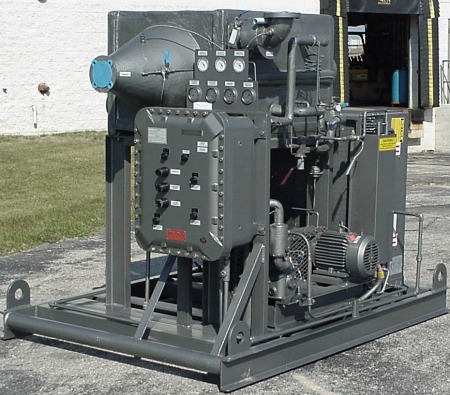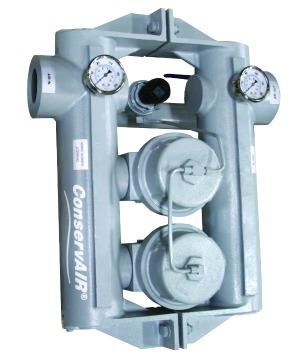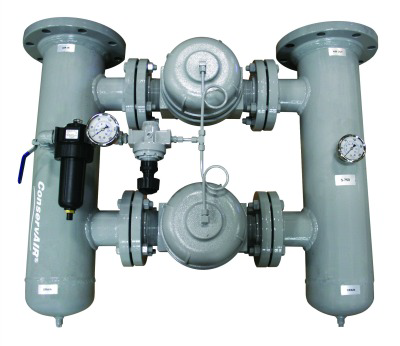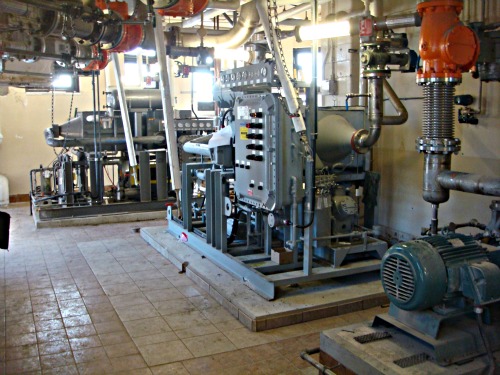Energy efficiency and sustainability solutions are often associated with more obvious initiatives--such as installing compact fluorescent bulbs—but those solutions fail to dig deeper for the “hidden gems” that can have a much greater impact. For manufacturing and building engineers or anyone else dealing with high potential energy consumption and inrush current demands, compressed air systems are one of the first places to look for significant energy savings and greater sustainability.
One reason why improvements in compressed air energy efficiency and sustainability are so important is that the overall system, from the compression process to the distribution network, inherently has losses in most systems. Although compressed air systems are essential to many manufacturing and building operations—and often save these operations substantial amounts of time, energy and money when configured and used properly—typically every two psi of unnecessary or lost pressure can equate to 1 percent of the annual energy expenditure, so there is tremendous potential for improvement.
Enter Pneumatech, head-quartered in Rock Hill, South Carolina and with a state-of the-art production facility in Houston, Texas. Pneumatech is an industry-leading ISO 9001:2008 Certified manufacturer of compressed air and gas treatment solutions to production facilities across the globe. The company has long recognized the importance of managing resources, including compressed air programs and biogas recovery.
|
The Pneumatech ConservAir S-150 Intermediate Control® is part of a line of controls designed to stabilize air pressure by adjusting flow. |
One way Pneumatech helps to make compressed air systems more efficient is with their line of ConservAIR® Intermediate Control (I/C)® units, which monitor and stabilize air pressure by adjusting flow and releasing air from storage to maintain a continuous, optimal air pressure supply within zones. Adjusting air flow to use the right pressure for the zones with a compressed air system is essential for optimal compressed air energy efficiency—and ConservAir I/C units do just that.
“In the early 1990s, the originators of the ConservAir technology saw the benefits of dividing the air flow into multiple parallel paths, thus reducing the distance traveled by the air,” said Joseph A. Fresch, Vice President, Pneumatech North America. “If you split the flow into two valves, it has to travel much less to provide the same pressure compensation.”
“The benefit,” added Fresch, “is that you react much quicker in changes in downstream demand. You have less overshoot or undershoot (than with a single valve system).”
One reason for the success of the ConservAir (now a division of Pneumatech) since its founding in 1988 has been that their systems do not depend on sophisticated electronic controls. Instead they rely on the multiple valve system described above. “In our smaller sizes we have multiple parallel valves,” Fresch said. “We utilize diaphragm- type valves on systems up to 600 horsepower. These valves are controlled with a pilot regulator. You set the outlet pressure to where you want it, and it senses when pressure wants to rise. The valves choke off to maintain the setpoint. If there is a lot of demand, it senses pressure wanting to go down and adjusts both parallel valves to allow for more air.”
Pneumatech was introduced to ConservAir in 1988, when two Pneumatech distributors, Bob Wilson and Bob Marel, brought the company to the attention of Pneumatech management. Pneumatech sent an engineer out to investigate installations and found that by using multiple valves, ConservAir was able to avoid expensive, sophisticated controllers and control air more efficiently. “My dad was an old manufacturing guy at Ford and realized many of his issues were pressure related – he saw the value [of the ConservAir solutions],” Fresch said. Impressed with the results of the ConvervAir solutions, Pneumatech bought a controlling interest in ConservAir in 1991.
The Meaning of Intermediate Control
|
Pneumatech ConservAIR S-750 Intermediate Control. ConservAIR Intermediate Controls provide minimum compressed air pressures while continually satisfying demand levels. |
One way to manage an efficient flow of compressed air would be to use a sophisticated regulator on every point of use in the plant. “You could do the same as ConservAir does and use all the piping as storage,” Fresch said. “One problem with that, however, is that operators usually misdiagnose problems with machines as lack of pressure, so they normally crank up the pressure. This would very often defeat the use of such regulators all over the plant.”
ConservAir takes a different approach, controlling pressure at the intermediate point in the plant. “You supply air to dryers, filters and a header,” Fresch said. “The intermediate control separates supply from demand. By putting it at the intermediate point (after the compressor and before the point of use), we put control in the hands of the compressed air supply – not the point of use equipment operators.”
Subzones of Pressure
The vast majority of systems use 85 psig, but there are often areas that need higher or lower pressure. A baghouse is an example where compressed air pulses under pressure to get the dust off the bags. You would use a secondary receiver controlled at 45 psig air, it fires in 2-3 seconds, you meter the recovery time over a five-minute span, and it is almost undetected by the air compressors because you’ve turned it into a constant load rather than a big event.
“A simple metering valve works like a gate valve that allows the tank to recover,” Fresch said. “A high-performance regulator would control the pressure at 45 psig and let the event happen. Of course, there might be parts of the system that need 110 psig, in which case you might have a line that bypasses the flow controller because this is what it needs.”
Systems can often be unnecessarily complex and inefficient. “So many systems are a hodgepodge of piping and units accumulated over time,” Fresch said. “We can make bad piping arrangements mediocre and mediocre ones good. It’s rare that we can’t go into an existing system and improve things without all new piping being required.”
We also offer electronically controlled butterfly valves. They use a sophisticated PID control to directly operate a rotary valve based on a pressure signal and without the need for any other complex valving to maintain pressure in the system. There is an overlap between the pneumatic and electronic flow controller designs to meet different customer preferences. I/C valves start at 850 cfm. The electronic flow controller starts at 2-inch, and they go up to an 8-inch, getting up to 9000 cfm flow.
Positive Results Confirmed
One confirmation of the usefulness of ConservAir I/F devices comes from Don Dyck of C.A.P.S. Inc. (Compressed Air Performance Specialists Inc.), a non-partisan compressed air system performance evaluation firm located in Calgary, Alberta (Canada). The many non-partisan services CAP Inc. provide include extensive performance evaluations to an entire compressed air system within all service sectors including the compressed air supply, air treatment/ management to the downstream CFM production/ process demand side.
CAPE (Compressed Air Performance Evaluation) reports are highly detailed reports of results that CAPS provides to clients, evaluating the entire compressed air systems performance and demand (kW) and energy (kWh) profile. The CAPE includes non-partisan recommendations to optimize compressed air systems and minimize the required horsepower/demand and annual energy consumption.
“Within the marketplace,” Dyck concluded in a recent CAPS case study of Pneumatech Intermediate Flow control units, “these units [are] extremely accurate. Two factors are the extremely low delta of 1 psi or less, and that they do not have the ability to backflow, as others do.”
Dyck goes on to say that the I/C units are “the singular device which I incorporate into my designs and installations which then guarantees that the compressed air system is going to give my client the savings that I propose. If I say we’re going to have a minimum \$48,536 of energy savings, then the compressor, dryer and remote air receivers are all an integral part of the recommendations. But without that ConservAir unit, appropriately installed, those savings are not achievable. The ConservAir units become an extremely important factor in saving the client real money on their energy costs. Many so-called compressed air systems auditors are running around saying ‘do this or do that,’ or ‘fix your air leaks and your problems are over.’ But I go much deeper than that. The ConservAir unit essentially becomes the matriarch of the entire system.” Dyck illustrates this with a recent case in point. “I measured 98 to a little better than 100 acfm of non-production demand in the plant,” he said, “and only about 8.3 acfm of that demand was directly attributable to air leaks.” The remainder (91.7 acfm) of that demand went to equipment left on and other ancillary demand. When Dyck goes into a plant initially, a leaking ¼-inch copper tube (for example) might be at 100-120 psig, but later operates at 70-75 psig after the installation of the ConservAir I/C units. “The 91.7 (acfm) would go down (because of the lower pressure necessary), but does not represent the ancillary demand that the client must still address in fixing the leak,” he said.
The ConservAir I/C units are “extremely important in capturing the savings which we identify. Running it in low/no load, I will capture much more savings”.
“Those Intermediate Control units are an extremely important part of what I do,” he said. “I don’t tell a client ‘you have to use this particular unit,’ but I do say, ‘this is what the unit has to perform, this is the criteria that it has to meet.’ ConservAir is one of the few who even come close to meeting those requirements. Their product has made my success rate virtually 100 percent.”
Pneumatech has become one of the “essential ingredients” in the CAPS program for reducing energy costs, which are delivering impressive results (see chart below). “During the….new equipment installation period,” Don stated in his case study, “the client made initial alterations, repairs and eliminations to those devices and/or areas recommended by CAPS Inc. within the CAPE report to reduce the overall compressed air ACFM demand required to operate all of the facilities’ various production and non-production periods. Although not all downstream ACFM demand reductions had yet been completed by the client upon the commissioning of the new compressed air system inclusive of the intermediate control device.” The following annual energy savings were measured/tested and quantified by CAPS Inc.:

Pneumatech Biogas Dryers Support Sustainability
Energy efficiency is one aspect of sustainability where Pneumatech compressed air solutions excel. But energy savings and sustainability are engineered into all of their solutions. One important example is biogas dryer solutions that are used on farms, landfills, and other sources of gas composition to reduce carbon and other pollutants emanating from them. Biogas processes entail both aerobic and anaerobic sources.

MVC 195F Gas Dryer, one of a line of dryers used to prepare gasses from landfills, farms and other operations for combustion.
“Landfills are not the only source of biogas, but they are the most easily understandable source,” said Fresch. “You have to do something with the methane gas (resulting from waste decomposition). You can’t just exhaust it, and it has been 30 years since people started to realize the importance of providing productive uses for the gas.”
Pneumatech manufactures driers and dryer filters that are used to dry and compress the landfill methane, making it ready for combustion. “The prepared methane is then ready for electricity generation,” Fresch said, most often in nearby industrial applications. In some cases the methane “can be cleaned up so well that it can be added to natural gas in pipelines.”
Today the company participates in close to 75 biogas sites of all types, including many landfill sites, in the US and Canada. There are also 4-5 sites in Mexico, several of them used in well known breweries, some of Mexico’s largest beer distillers. Waste hydrocarbon gases are captured from the by-products of the beer’s fermentation process, cleaned up and utilized to fuel boilers and supplement natural gas requirements they may have at the facility.
In a landfill to energy project, gasses are developed within the system and collected. A compressor or a blower creates suction that pulls the gases out of the landfill. Scrubbers take some of the gross materials out of the gas stream for the compressor.
A typical Pneumatech “landfill skid package” includes, among other items, a chiller and re-heater. The gas will come in and be pre-cooled by outgoing gas, and then the gas goes to a direct expansion unit or chiller that cools it down to 40 degrees. The moisture in the gas condenses and is pulled out with a separator. The gas is then reheated and a coalescing filter pulls out any oil. The gas in most cases then goes straight to micro-turbines or generators that produce electricity.
“In some localities, any electricity generated in that way is required to be purchased by the people who maintain the electrical grid,” Fresch said. In addition to the sustainability benefits of reduced carbon pollution, “there are also financial benefits to doing this. They are basically taking what was once a waste gas and turning something tangible, usable and saleable.”
The amount of recoverable gas depends on the size of the landfill, and when the landfill closes, its lifecycle stage. “Early in the process, it doesn’t produce that much,” he said, but a much more significant production occurs soon thereafter. “Typically, years two through eight maximize the amount of gas available,” he said, “but after year eight it starts to fall off.”
The filters used can get to be as much as 5’8” or more tall and 3 feet wide, with a 10-year filter life. “So much material packed into space allows movement of gas,” Fresch said. “The gas flow is slowed by the filter’s design, which maximizes contact with the filter media.”
Advantages of Pneumatech Biogas Systems
|
|
|
These are PAC-1.7 LDS/40 model dryers installed at the city landfill in Barrie, Ontario. |
“Several packagers use some of the components that we use, Fresch said. “Pneumatech considers itself to have an advantage by having done this and from being known in the industry for a long time, offering efficient units featuring innovations developed over a period of time.“ Interested in enhancing your company’s energy savings and improved sustainability? Go ahead and install those energy saving light bulbs. And when you’re done, take a closer look at your compressed air programs—where you may find even greater savings and impact on the environment.
To read more Technology articles, visit www.airbestpractices.com/technology







